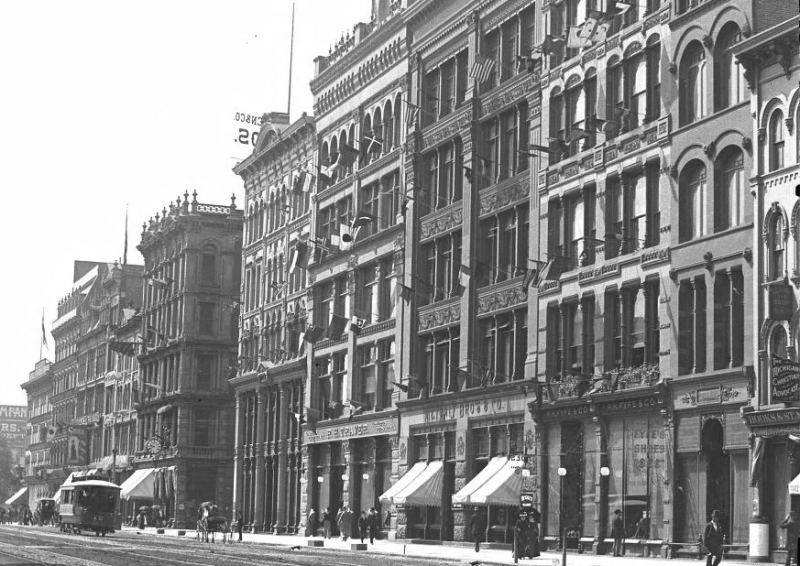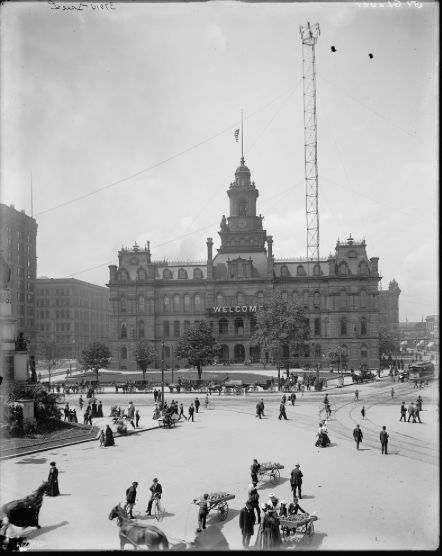
When work began on the El Moore, we were intrigued by the discovery that the builder had run parallel lines, gas and electric, for some of the lighting fixtures. Why both? What was going on back then? Of course, we had to learn more!
We know that the 1880’s and 1890’s were a period of transition for the city, particularly in the area of new technologies. The automobile industry was in its earliest stages and new illuminating technologies were also making their appearance in Detroit. In the middle of the century, oil and kerosene gave way to gas lighting for homes and businesses, as well as street lights. The early 1880’s saw the installation of electric arc lamp towers, also known as moonlight towers, across the city. Arc lamps provided much brighter light than the old gas street lights and Detroit had one of the most extensive systems of these towers in the country – 122 towers lighting 21 square miles of the city.

But the winds of change were blowing, and a new technology was coming that would replace gas lighting and the arc lamp towers. In 1883, Detroiters gathered at Metcalf Brothers Dry Goods Store on Woodward Avenue to get their first glimpse of an incandescent light bulb. Interest in using electric lighting as a new way of illuminating one’s home or business was tremendous and private power companies competed to provide electric service across the city. Among these pioneer power companies was the Detroit Electric Light and Power Company, the Peninsular Electric Company and the Edison Illuminating Company, the latter of which a young Henry Ford was chief engineer (before he moved on to bigger and better things, of course)!
The transition from gas to electricity took place over the last decades of the 19th century and into the early 20th. The El Moore was built during this time and we can be sure that builder Charles Moore knew that electricity was the future. So why run gas lines as well? We can speculate that electrical service at the turn of the century wasn’t considered quite reliable enough to ensure consistent service. Or, as with many emergent technologies, maybe people weren’t quite ready to put their complete trust in something so new. This might explain the presence of the parallel lines that we found.
Well, technology marches on – and even more quickly today than it did over 100 years ago. There were a couple of technology-related decisions that we had to make in the renovation of the El Moore that reflect the rapid pace of change. One of them was phone jacks. Twenty years ago there would have been no question – every room/apartment most certainly would have been supplied with phone jacks because just about everyone had a land line that needed that connection. Not so today. With the prevalence of cell phones, phone jacks seemed unnecessary, so no phone jacks at the El Moore. The other thing we had to consider was whether or not to put in coaxial cable jacks (you know, to connect your TV to cable service). With the internet options available now that allow you to stream your favorite shows and movies to your TV or computer, were cable jacks really necessary? Because this is a technology that is still in transition, many people haven’t yet moved to internet streaming and rely on cable connections, so the decision was made to install cable jacks. But who knows, a hundred years from now someone may be doing renovations on the El Moore, come across the cable jacks and wonder, as we did with the gas lines, why are those things there?
Readers interested in more in-depth information about the electrification of Detroit should take a look at this excellent article from Model D by local historian Amy Elliott Bragg.
